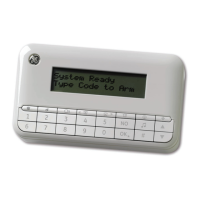NetworX Version 3 Installation Manual
180
After the siren/IO module is learned-in you need to set up threshold values and turn the
antipassivation feature ON, if necessary. Lithium cells require regular exercising to prevent electrode
passivation, which leads to an increase of the internal cell resistance. Antipassivation is a function
that avoids formation of this passivation layer. The following example sets the threshold low battery
value to 30 x 0.1 V, threshold low auxillary voltage to 98 x 0.1 V and turns the antipassivation
feature ON for the RF siren/IO module 1.
1. Navigate with the ½¾ keys to RF Receivers>RF Receiver 32>Sirens/IO Features and
press OK.
2. Scroll to RF Siren/IO 1 and press OK.
3. Scroll to Threshold and press OK.
4. Scroll to Low Battery and press OK. Set the low battery threshold to 30 x 0.1 V with the
½¾ keys and press OK. The keypad beeps once to accept the change and returns to Low
Battery.
5. Scroll to Low Aux Voltage and press OK. Set the low auxillary voltage threshold to
98 x 0.1 V with the ½¾ keys and press OK. The keypad beeps once to accept the change
and returns to Low Aux Voltage.
6. Navigate with the ½¾ keys to Sirens/IO Features>RF Siren/IO 1>Antipassivation and
press OK.
7. Select Enabled and press OK.
8. The keypad beeps once to accept the change and returns to Antipassivation.
Recommended settings depend on the type of application the IO module is used for, and are as
follows:
Application Low Battery Trip Antipassivation
Operational battery 3.0 V Outdoor Siren
Siren battery 9.8 V
Enabled
Operational battery 2.3 V Indoor Siren
Siren battery 9.0 V
Disabled
Standalone IO module Operational battery 2.3 V Disabled
Setting supervision windows
There are three wireless supervision options: Short Window, Normal Window and Fire Window. The
PIR sensor and door/window sensors follow the short and normal supervision windows.
• If a PIR or door/windows sensor does not report within the time specified in Short
Window, the system does not allow the user to arm the system.
• If a PIR or door/windows sensor does not report within the time specified in Normal
Window, an RF Sensor Lost condition is reported to the central station and a service
message is displayed on the keypad.
868 MHz transmitters typically report every 20 minutes.
Note: If you are installing a system in Holland or Belgium, you must set the supervision values to 2 hours as long
supervision window. Set the short supervision window in Belgium and Holland to 24 minutes. Fire transmitter
supervision windows should be set to 4 hours.

